 Technology
Technology  Technology
Technology  Humans
Humans 10 Everyday Human Behaviors That Are Actually Survival Instincts
 Animals
Animals 10 Animals That Humiliated and Harmed Historical Leaders
 History
History 10 Most Influential Protests in Modern History
 Creepy
Creepy 10 More Representations of Death from Myth, Legend, and Folktale
 Technology
Technology 10 Scientific Breakthroughs of 2025 That’ll Change Everything
 Our World
Our World 10 Ways Icelandic Culture Makes Other Countries Look Boring
 Misconceptions
Misconceptions 10 Common Misconceptions About the Victorian Era
 Mysteries
Mysteries 10 Strange Unexplained Mysteries of 2025
 Miscellaneous
Miscellaneous 10 of History’s Most Bell-Ringing Finishing Moves
 Technology
Technology Top 10 Everyday Tech Buzzwords That Hide a Darker Past
 Humans
Humans 10 Everyday Human Behaviors That Are Actually Survival Instincts
 Animals
Animals 10 Animals That Humiliated and Harmed Historical Leaders
Who's Behind Listverse?

Jamie Frater
Head Editor
Jamie founded Listverse due to an insatiable desire to share fascinating, obscure, and bizarre facts. He has been a guest speaker on numerous national radio and television stations and is a five time published author.
More About Us History
History 10 Most Influential Protests in Modern History
 Creepy
Creepy 10 More Representations of Death from Myth, Legend, and Folktale
 Technology
Technology 10 Scientific Breakthroughs of 2025 That’ll Change Everything
 Our World
Our World 10 Ways Icelandic Culture Makes Other Countries Look Boring
 Misconceptions
Misconceptions 10 Common Misconceptions About the Victorian Era
 Mysteries
Mysteries 10 Strange Unexplained Mysteries of 2025
 Miscellaneous
Miscellaneous 10 of History’s Most Bell-Ringing Finishing Moves
10 Mind-Bending Facts About Sea Stars
Familiar yet undeniably alien, starfish are bizarre creatures that inhabit a wide range of ocean environments. Their appearance frequently matches the popular depiction of their celestial namesake, but those freaky bodies hold plenty of surprises. What creature could lack a brain but have eyes on its feet, or have no blood but be able to digest outside of its body? Get ready to learn about creatures that often seem to defy the laws of animal biology.
10They’re Not Always Star-Shaped
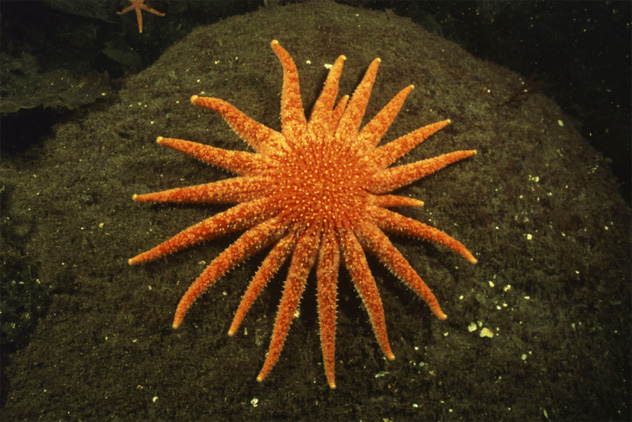
The name “starfish” alone elicits immediate thought of the traditional five-point sea star that we commonly see in tide pools, but sea star shapes are very diverse. Commonly present in the right habitats yet far lesser known, sun stars—or sunflower stars—can be enormous and shaped more like a real star with their rounded bodies and multiple “rays” that extend outward. The largest sea stars in the Pacific Northwest, sun stars can measure 1 meter (3 ft) across and can weigh up to 5 kilograms (11 lb) with some of the most well-endowed species sporting over 20 arms.
Sun stars are more active than a lot of other starfish species, and they’re more than capable of chasing after fast-moving prey. They’re also strong enough to rip apart mollusc and crustacean shells. Barnacles and large nudibranches also wind up on the menu. Sunflower stars are expert stalkers and will surprise and seize their prey before it has a chance to escape. While native to colder waters, sun stars come in truly tropical colors. They may form large groups in particularly rich feeding areas.
9No Blood, No Brains, No Problem

Sea stars are complex and strange animals, yet in many ways, their bodies are also rather primitive. While they have highly adapted stomachs and exceptionally well-developed “skin,” sea stars lack brains and have absolutely no blood. Lacking a bloodstream or gills, starfish live by pumping seawater through their bodies to deliver nutrients, oxygen, and other essential fluids. As a replacement for blood, seawater is distributed through their bodies via a system known as a “water vascular system.” Radiating through the body of a sea star are canals filled with sea water that’s moved through a complex system of corpuscles and spiral systems.
Sea water is circulated through the body in an almost mechanical manner, with muscles and lymphatic glands working to move and adjust the chemistry of the water. Sinuses and various corpuscle and tube systems all work together to make the system work to maximum effectiveness, all without the presence of blood. The starfish body is still something of a mystery, and we still don’t entirely understand how they work. The scientific exploration of the starfish body remains one of the most interesting biological subjects on this planet.
8Sticky Feet
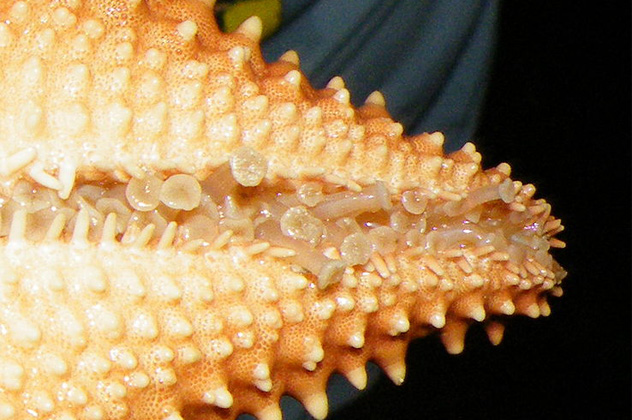
We may call the extensions running outward from a sea star’s body “arms,” but they all have feet attached. Look closely at the underside of a starfish, and you’ll find something surprising: On each arm, there may be up to 15,000 tiny tube feet that move in caterpillar-like synchronization, propelling the starfish forward at an efficient pace. In the intertidal zone, the tube feet hold the star fast to rocks when the waves might otherwise dislodge and smash them to pieces.
Anchored by their tube feet, the soft underbelly of the star will hug the rock, while the “back” of the star is covered by tough, leathery skin which takes the majority of the heat, dryness, and sunlight. Scientific investigations continually reveal astonishing new facts about nature, and one of these findings is the existence of a powerful foot glue in sea stars. Their feet can form a glue that will bond indefinitely with a rock or prey item, with an adjacent tube releasing a solvent to undo the bond once the star is ready to move on.
7Cannibalism
Most of us think of sea stars as the ocean’s decorations, but we’re quickly learning that sea stars more often take the role of voracious predators than passive grazers. It might come as a greater surprise to learn that cannibalism is also a well-documented fact of life for these strange creatures. After stalking their prey, sea stars will engulf the catch and invert their stomach to begin digestion. This cannibalistic behavior is often provoked by reductions in normal food supplies.
With their tough, leathery skin, sea stars are usually challenging prey for hunters, but sea stars are well equipped to take down their own kind. Certain sea stars are not averse to taking smaller individuals, even of their own exact species. One cannibalistic species is the chocolate chip sea star. It’s a species favored by aquarists, who often learn the hard way that they can’t put small individuals together with large ones.
6Sea Stars Are Aggressive Predators With Two Stomachs
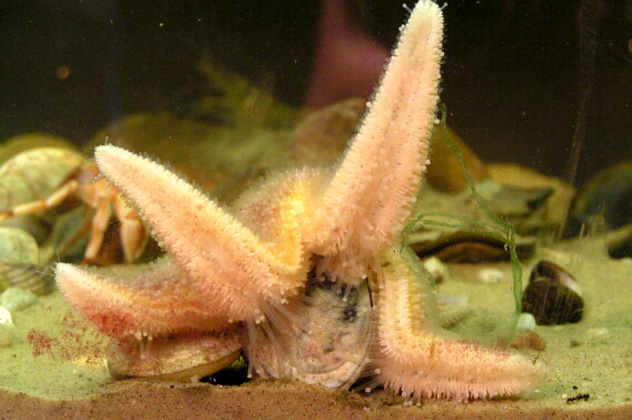
Sea stars look attractive, but they are voracious predators with two stomachs that give them exceptional hunting abilities. One of their more bizarre traits is their ability to eject their stomachs. Using pressure exerted by the water vascular system, the cardiac stomach can be pushed outside of the sea star’s body and inserted inside a shellfish. After a sea star opens its prey’s shell by gluing its feet to the outside and forcibly ripping the shell apart, it’ll shoot its own stomach into the shell. The inverted stomach actually digests the animal inside its shell and turns it into a liquefied soup. Supported by ligaments, the stomach then brings the food back into the sea star for stage two of digestion.
Known as a pyloric stomach, this mechanism is strangely complicated, with extensions called ceca that follow the shape of the sea star to absorb and deliver nutrients throughout the body. The pyloric stomach is located in the central location above the cardiac stomach, processing and releasing nutrients through the pyloric ceca. These advanced digestive organ components form two rows of what look like multiple dendrites strung out within each arm. Each arm of the pyloric stomach has two pyloric ceca. The entire digestive process of a sea star is one of incredible complexity and evolutionary progress, especially considering how primitive the creatures are in other respects.
5The Crown-Of-Thorns Situation

No popular review of sea star ecology would be complete without mentioning the environmental danger posed by the crown-of-thorns starfish. Occurring throughout the Indo-Pacific, the crown-of-thorns starfish stands out by combining the form of a sea star with the spiked exterior associated with urchins. Covered in venomous spines, these creatures may measure nearly half a meter (1.6 ft) across, posing a threat to careless divers and swimmers as well as coral reefs. Doubling of phytoplankton levels has been linked to 10-fold increases in the populations of these animals. Changing ocean temperature and currents, as well as declines in natural predators, have also been suggested as potential factors in population booms.
Low populations of crown-of thorns starfish contribute to the diversity of a reef by feeding on fast-growing acropoid coral, which gives slow-growing corals a chance to take hold. On the other hand, spikes in the population of these echinoderms can cause significant damage to coral reefs. One of the most serious cases involves damage to the Great Barrier Reef. Declines of 50 percent in total coral cover on surveyed reefs over 30 years showed that half of that decline could be attributed to crown-of-thorns starfish population overgrowth.
4Bizarre Cushion Stars
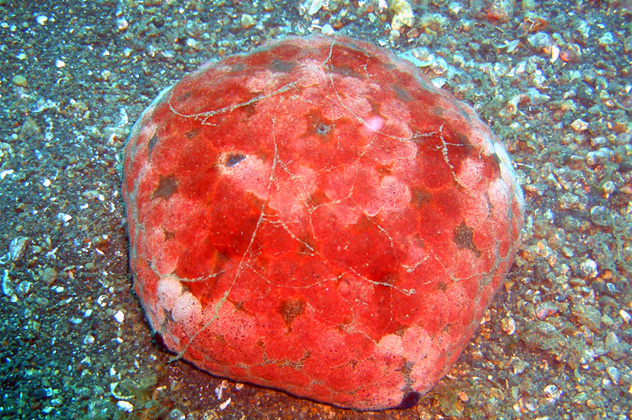
Sea stars as a group are named after their star-like appearance, but some species have taken on a completely different appearance. While genetically remaining true sea stars, the cushion stars (Culcita novaeguinea) of the Indo-Pacific region would at first glance be unrecognizable as a member of the sea star group, having almost nonexistent arms and a puffy, blob-like body. Often covered in tiny little spines, these strange animals have developed the appearance of a pincushion. These creatures may measure over 25 centimeters (10 in) across and come in a range of colors.
While sea stars are typically very accomplished as predators, able to hunt shellfish and open them up with powerful tube feet, cushion stars are much gentler animals with less dramatic lifestyles. They mostly feed on detritus, plant material, and sometimes coral. The cushion star also serves as a sort of home for other species of marine animal in a strange symbiotic relationship system. Small fish may live inside the main body cavity of this sea star, which is filled with water, while invertebrates on the outside clean the prickly spines.
3The Mysterious Sea Star Wasting Affliction
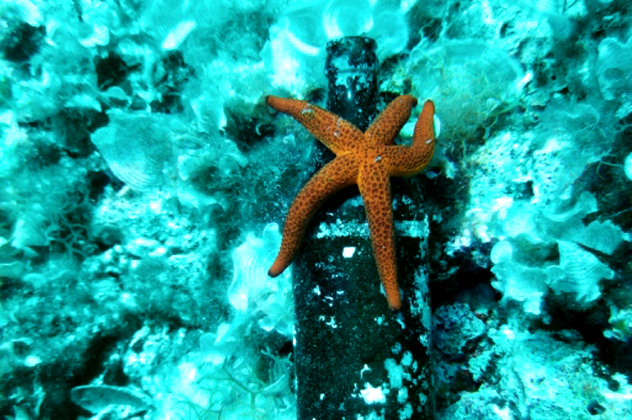
Recent news stories of catastrophic sea star die-offs have brought the plight of these marine creatures to popular attention. Starfish wasting disease, which leads to mass die-offs through decay, lesion formation, and ultimate fragmentation of the animal, has been potentially linked to a densovirus. This is especially true of the 2014 die-off along the Pacific Northwest coast. Sea star die-offs from true cases of sea star wasting disease shed light on the vulnerability of populations to infections, which may have differing pathogenic causes. The die-offs are not unprecedented, but they do pose a threat to keystone species and have attracted great concern in the conservation community.
Massive die-offs of sunflower stars along Vancouver Island have been noted, while other species of sea stars were affected all along the west coast from Mexico to Alaska. Differing species of sea stars exhibit different levels of susceptibility. Key questions remain as to what exact ecological consequences the decline of sea stars could have when it comes to the health and biodiversity of marine environments. Further questions include what environmental factors might increase the prevalence of infection. Possible environmental factors such as pollution are worth considering as a potential factor that might increase sea star susceptibility to infection and death through wasting. Research is still ongoing, and the public is being asked by organizations such as the Vancouver Aquarium to submit observations.
2Sea Stars Have The Weirdest Eyes
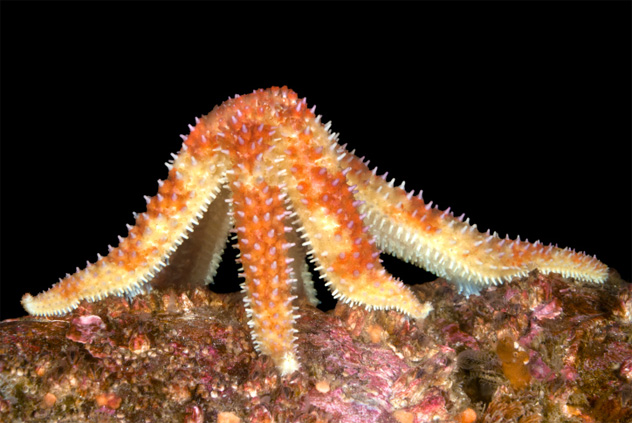
Due to their lack of blood, a typical central nervous system, and any sort of face, we might naturally assume that sea stars also lack eyes. However, sea stars do have eyes that give them the ability to navigate, and they’re located in a pretty weird place: the tips of their arms. These eyes gather visual information to guide the sea star from any direction, and they’re similar in form and structure to the eyes seen in arthropods such as insects and crustaceans. It has long been known that sea stars have eyes, but how they could see without a brain was a prominent question.
Recent studies, however, have now shown how sea stars use their eyes to navigate their way around marine habitats with a fair degree of precision. An investigation by Anders Garm from the University of Copenhagen and Dan-Eric Nilsson of Lund University showed how blue starfish would move around in an undirected manner until coming within 2 meters (6.5 ft) of a reef. Visually sensing the reef, the sea stars would make a beeline for their desired environment. The light-detecting cells work slowly, and sea stars are color-blind, but it appears that steady images such as reefs stand out as dim splotches to guide the animal.
1Sea Stars Can Switch Gender At Will
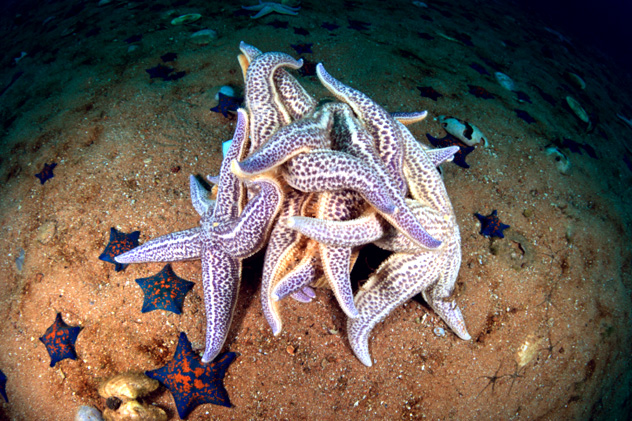
Often, the simpler an animal is, the more remarkable its abilities are, such as regenerating parts or switching gender. Certain sea stars can start out as one gender, switch, and then even switch back at a later date. Reasons for switching genders are diverse, and may include breeding convenience and various responses to water quality, temperature, and food availability. Gender differences in sea stars are subtle from an external perspective, though males are smaller than females in certain species. Even flipping a sea star over may not always indicate its gender.
While most species are born as either male or female, the cushion star is always born male, with individuals switching to female later in life. Sea star sexuality has many unusual aspects. First of all, some species have both male and female sex organs and can take on either role while mating. Second, sea stars do not generally touch while mating, but release sperm and eggs into the water to mix. Third, some sea stars are “protective” of their young, carrying them on their back until they are ready to make their own way along the ocean floor.
Christopher Stephens is a researcher and writer based in British Columbia, Canada. He completed his M.Sc. in Environment and Management and enjoys writing about health, science, and environmental studies. An experienced naturalist, he leads world-class birdwatching tours for Pacific Rainforest Adventure Tours in B.C.








